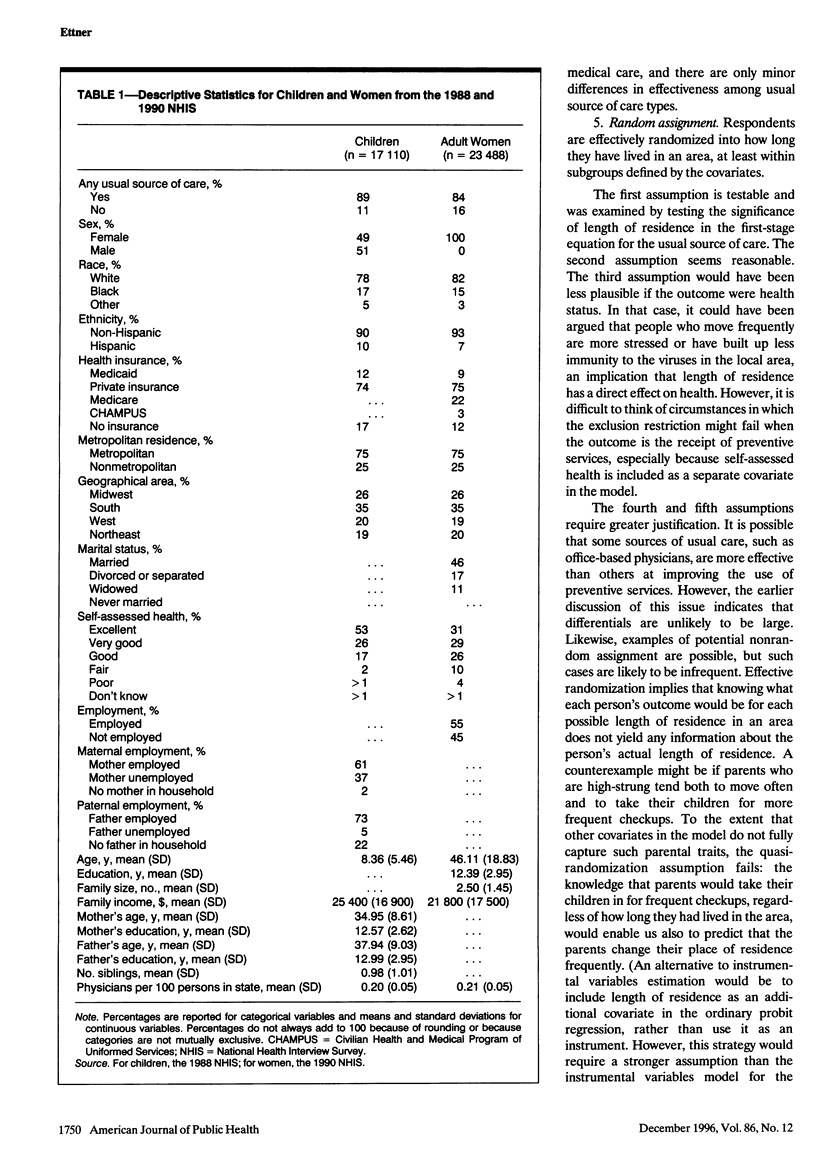Abstract
OBJECTIVES: This study investigated the causal effect of having a usual source of medical care on the timing of preventive services by women and children. METHODS: Data on 17,110 children and 23,488 women from the 1988 and 1990 National Health Interview Surveys were used to estimate ordered probit models of the effect of having a usual source of medical care on the time since the last receipt of each preventive service (routine checkups for children; blood pressure checks, Pap smears, and breast exams for adult women; mammograms for older women). Two-stage instrumental variables methods were used to eliminate simultaneity bias. RESULTS: The existence of a usual source of medical care was strongly correlated with the earlier receipt of preventive services, and the relationship appears to be causal for Pap smears, breast exams, and mammograms. However, there was little evidence that having a regular provider caused an increased rate of routine checkups for children or blood pressure checks for adult women. CONCLUSIONS: Delivery systems that encourage the development of long-term relationships with medical providers may increase cancer screening rates among women.
Full text
PDF






Selected References
These references are in PubMed. This may not be the complete list of references from this article.
- Baker D. W., Stevens C. D., Brook R. H. Regular source of ambulatory care and medical care utilization by patients presenting to a public hospital emergency department. JAMA. 1994 Jun 22;271(24):1909–1912. [PubMed] [Google Scholar]
- Bernstein A. B., Thompson G. B., Harlan L. C. Differences in rates of cancer screening by usual source of medical care. Data from the 1987 National Health Interview Survey. Med Care. 1991 Mar;29(3):196–209. [PubMed] [Google Scholar]
- Cohen J. W. Medicaid physician fees and use of physician and hospital services. Inquiry. 1993 Fall;30(3):281–292. [PubMed] [Google Scholar]
- Dietrich A. J., Marton K. I. Does continuous care from a physician make a difference? J Fam Pract. 1982 Nov;15(5):929–937. [PubMed] [Google Scholar]
- Hearst N., Newman T. B., Hulley S. B. Delayed effects of the military draft on mortality. A randomized natural experiment. N Engl J Med. 1986 Mar 6;314(10):620–624. doi: 10.1056/NEJM198603063141005. [DOI] [PubMed] [Google Scholar]
- Kasper J. D. The importance of type of usual source of care for children's physician access and expenditures. Med Care. 1987 May;25(5):386–398. doi: 10.1097/00005650-198705000-00003. [DOI] [PubMed] [Google Scholar]
- Lambrew J. M., DeFriese G. H., Carey T. S., Ricketts T. C., Biddle A. K. The effects of having a regular doctor on access to primary care. Med Care. 1996 Feb;34(2):138–151. doi: 10.1097/00005650-199602000-00006. [DOI] [PubMed] [Google Scholar]
- Manning W. G., Leibowitz A., Goldberg G. A., Rogers W. H., Newhouse J. P. A controlled trial of the effect of a prepaid group practice on use of services. N Engl J Med. 1984 Jun 7;310(23):1505–1510. doi: 10.1056/NEJM198406073102305. [DOI] [PubMed] [Google Scholar]
- Marcus A. C., Stone J. P. Mode of payment and identification with a regular doctor. A prospective look at reported use of services. Med Care. 1984 Jul;22(7):647–660. doi: 10.1097/00005650-198407000-00007. [DOI] [PubMed] [Google Scholar]
- McClellan M., McNeil B. J., Newhouse J. P. Does more intensive treatment of acute myocardial infarction in the elderly reduce mortality? Analysis using instrumental variables. JAMA. 1994 Sep 21;272(11):859–866. [PubMed] [Google Scholar]
- McWhinney I. R. Continuity of care in family practice. Part 2: implications of continuity. J Fam Pract. 1975 Oct;2(5):373–374. [PubMed] [Google Scholar]
- Rundall T. G., Wheeler J. R. The effect of income on use of preventive care: an evaluation of alternative explanations. J Health Soc Behav. 1979 Dec;20(4):397–406. [PubMed] [Google Scholar]
- St Peter R. F., Newacheck P. W., Halfon N. Access to care for poor children. Separate and unequal? JAMA. 1992 May 27;267(20):2760–2764. [PubMed] [Google Scholar]
- Weissman J. S., Stern R., Fielding S. L., Epstein A. M. Delayed access to health care: risk factors, reasons, and consequences. Ann Intern Med. 1991 Feb 15;114(4):325–331. doi: 10.7326/0003-4819-114-4-325. [DOI] [PubMed] [Google Scholar]


